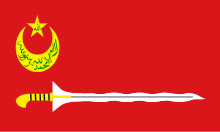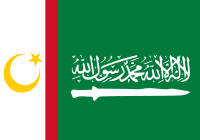Ilaga
| Ilaga | |
|---|---|
| Participant in Moro conflict | |
| Active |
1971 – 1979 2008 - ? (re-formed as 'New Ilaga') |
| Ideology | Folk Catholicism |
| Leaders | Norberto Manero, Jr. (formerly) |
| Headquarters | North Cotabato |
| Area of operations | Mindanao, Philippines |
| Opponents |
|
The Ilaga is/was a right-wing paramilitary group in the southern Philippines predominantly composed of Visayans (mostly Ilonggo), embracing a form of Folk Catholicism that utilized amulets and violence. The group complemented the Philippine Constabulary as a militia force during the 1970s in southern Mindanao while fighting against Moro guerrillas during the Moro insurgency in the Philippines.[1]
The group committed its bloodiest act on June 19, 1971, when the group killed 65 Moro civilians inside a mosque.[2]
Background
The Mindanao region is rich in natural resources, including large quantities of mineral reserves. The American colonial government and subsequently the Philippine government pursued a policy of migration by resettling significant numbers of Christian Filipino settlers from the Visayas and Luzon onto tracts of land in Mindanao, beginning in the 1920s. This policy allowed Christian Filipinos to outnumber both the Moro and Lumad populations by the 1970s, which was a contributing factor in aggravating grievances between the Moro and Filipino Christian settlers as disputes over land increased. Another grievance by the Moro people is the extraction of Mindanao's natural resources by the central government whilst many Moros continued to live in poverty.
The Philippine government under Ferdinand Marcos particularly encouraged (allegedly) Ilonggo settlers who had emigrated to Mindanao to form a militia, which was eventually called the Ilaga. There is anecdotal evidence that the Ilaga often committed human rights abuses by targeting the Moro and Lumad peoples, as well as attempting to seize additional territory.
The end result of Ilaga extremism is the lingering animosity between Moro and Christian communities. Mistrust and a cycle of violence are still felt today due to the creation of the Ilaga.
Manili massacre
Violence attributed to the Ilaga reached its climax in June 1971 with the Manili massacre of 65 men, women and children at Barangay Manili in Carmen, North Cotabato.[2] The group was composed of Christian villagers allegedly used by the Philippine Constabulary to attack Moro communities. It was reported that some members cut off the ears of dead Moro and wore them around their necks as trophies. One senior member, Norberto Manero, aka Kumander Bukay, also gained notoriety in the 1980s after he was convicted of murdering and cannibalizing the brain of Italian priest Tullio Favali, whom he had suspected of having links with Communist insurgents, yet Manero was later released.[3]
See also
References
- ↑ "Anti-Moro group resurfaces in NCotabato". philstar.com. Retrieved 26 January 2015.
- 1 2 Marco Garrido (March 6, 2003). "The evolution of Philippine Muslim insurgency". Asia Times Online. Retrieved September 14, 2008.
- ↑ "Priest killer Manero freed". YouTube. Retrieved 26 January 2015.
External links
- “Ilaga revival to make things worse – Piñol” Philippine Daily Inquirer, retrieved September 14, 2008

